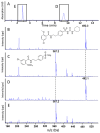Impact of Hot-Melt Extrusion on Glibenclamide's Physical and Chemical States and Dissolution Behavior: Case Studies with Three Polymer Blend Matrices
- PMID: 39204416
- PMCID: PMC11360095
- DOI: 10.3390/pharmaceutics16081071
Impact of Hot-Melt Extrusion on Glibenclamide's Physical and Chemical States and Dissolution Behavior: Case Studies with Three Polymer Blend Matrices
Abstract
This research work dives into the complexity of hot-melt extrusion (HME) and its influence on drug stability, focusing on solid dispersions containing 30% of glibenclamide and three 50:50 polymer blends. The polymers used in the study are Ethocel Standard 10 Premium, Kollidon SR and Affinisol HPMC HME 4M. Glibenclamide solid dispersions are characterized using thermal analyses (thermogravimetric analysis (TGA) and differential scanning calorimetry), X-ray diffraction and scanning electron microscopy. This study reveals the transformation of glibenclamide into impurity A during the HME process using mass spectrometry and TGA. Thus, it enables the quantification of the extent of degradation. Furthermore, this work shows how polymer-polymer blend matrices exert an impact on process parameters, the active pharmaceutical ingredient's physical state, and drug release behavior. In vitro dissolution studies show that the polymeric matrices investigated provide extended drug release (over 24 h), mainly dictated by the polymer's chemical nature. This paper highlights how glibenclamide is degraded during HME and how polymer selection crucially affects the sustained release dynamics.
Keywords: degradation; glibenclamide; hot-melt extrusion; solid dispersion; sustained drug release; ternary blends.
Conflict of interest statement
The authors declare no conflicts of interest.
Figures












Similar articles
-
A New Extrudable Form of Hypromellose: AFFINISOL™ HPMC HME.AAPS PharmSciTech. 2016 Feb;17(1):106-19. doi: 10.1208/s12249-015-0395-9. Epub 2015 Sep 4. AAPS PharmSciTech. 2016. PMID: 26335416 Free PMC article.
-
Investigation of Thermal and Viscoelastic Properties of Polymers Relevant to Hot Melt Extrusion, IV: Affinisol™ HPMC HME Polymers.AAPS PharmSciTech. 2016 Feb;17(1):148-57. doi: 10.1208/s12249-015-0426-6. Epub 2015 Oct 28. AAPS PharmSciTech. 2016. PMID: 26511936 Free PMC article.
-
Application of HPMC HME polymer as hot melt extrusion carrier in carbamazepine solid dispersion.Drug Dev Ind Pharm. 2020 Dec;46(12):1911-1918. doi: 10.1080/03639045.2020.1821045. Epub 2020 Nov 13. Drug Dev Ind Pharm. 2020. PMID: 32942902
-
Interactions between drugs and polymers influencing hot melt extrusion.J Pharm Pharmacol. 2014 Feb;66(2):148-66. doi: 10.1111/jphp.12183. Epub 2013 Dec 11. J Pharm Pharmacol. 2014. PMID: 24325738 Review.
-
Hot Melt Extrusion: Highlighting Physicochemical Factors to Be Investigated While Designing and Optimizing a Hot Melt Extrusion Process.Pharmaceutics. 2018 Jul 11;10(3):89. doi: 10.3390/pharmaceutics10030089. Pharmaceutics. 2018. PMID: 29997332 Free PMC article. Review.
Cited by
-
Mechanistic Insights into Amorphous Solid Dispersions: Bridging Theory and Practice in Drug Delivery.Pharm Res. 2025 Jan;42(1):1-23. doi: 10.1007/s11095-024-03808-w. Epub 2025 Jan 23. Pharm Res. 2025. PMID: 39849216 Review.
References
-
- Choiri S., Sulaiman T.N.S., Rohman A. Characterization of Eudragit types and Kollidon SR inter-polymer complexes and their effects on the drug release. J. Appl. Pharm. Sci. 2019;9:58–68. doi: 10.7324/JAPS.2019.90708. - DOI
Grants and funding
LinkOut - more resources
Full Text Sources
Research Materials

